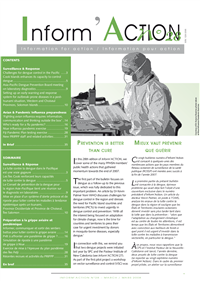Contents
Surveillance & Response
- Challenges for dengue control in the Pacific
Kevin Palmer (PDF, 97 KB) - Cook Islands enhances its capacity to control dengue
Justus Benzler, Christelle Lepers, Tuaine Teokotai and Charlie Ave (PDF, 284 KB) - Asia-Pacific Dengue Prevention Board Meeting on Laboratory Diagnostics
Tom Kiedrzynski (HTML, 9 KB) - Setting up an early warning and response system for outbreak-prone diseases in a post-tsunami situation, Western and Choiseul Provinces, Solomon Islands
Tom Kiedrzynski, Narendra Singh and Christelle Lepers (PDF, 93 KB)
Avian & Pandemic Influenza Preparedness
- ‘Fighting avian influenza requires information, communication and thinking outside the box’
Jimmie Rodgers (PDF, 89 KB) - Who’s ready for a flu pandemic (PDF, 97 KB)
- Niue Influenza Pandemic Exercise
Seini Kupu and Manila Nosa (PDF, 319 KB) - Fiji Pandemic Plan Testing Exercise
Ian Peebles (PDF, 84 KB) - New PRIPPP staff and related activities (HTML, 18 KB)
In Brief
- Pacific Paramedical Training Centre – Training courses 2008 (HTML, 13 KB)
- Comparison of PanBio Dengue IgM ELISA with Pentax Dengue IgM Particle Agglutination Assay to evaluate factors affecting false positive results (HTML, 13 KB)
Supplements
- Avian and Pandemic Influenza fact sheets
produced by UNICEF in collaboration with WHO, SPC and Japan Government (download pdfs of the fact sheets)-What is Bird Flu (Avian Influenza)?
-Current Situation of Bird Flu (Avian Influenza) in the World and in the Pacific
-Global Response to Bird Flu (Avian Influenza)
-The Spanish Flu Pandemic 1918 – The Most Devastating Pandemic in World History
-Prevention and Protection against Bird Flu
Editorial
Prevention is better than cure
In this 28th edition of Inform’ACTION, we cover some of the many PPHSN members’ public health actions that gathered momentum towards the end of 2007.
The first part of the bulletin focuses on dengue as a follow-up to the previous issue, which was fully dedicated to this important problem. An article by Dr Kevin Palmer from WHO discusses challenges for dengue control in the region and stresses the need for Pacific Island countries and territories (PICTs) to invest urgently in dengue control and prevention: ‘With all the interest being focused on adaptation for climate change, now is the time for countries and territories to press their case for urgent investment by donors in mosquito-borne diseases, especially dengue.’
In connection with this, we remind you that two dengue projects were initiated last year by SPC and the Pasteur Institute of New Caledonia (see Inform’ACTION 27). As part of the first pilot project a workshop on vector surveillance and control (VSC) was implemented in the Cook Islands in September 2007. A summary of this workshop and another one on mastering epidemiological data,(funded by WHO), is provided on page 5. The second project, which aims at extending VSC activities to all PICTs, is still being fine-tuned with the interested donor, the French Agency for Development (AFD). Correspondence has been sent to all PICTs in order to get feedback on the project. We hope that all PICTs will be interested in this initiative. ‘We should not pass up this chance,’ says Dr Palmer.
SPC’s Director-General, Dr Jimmie Rodgers, introduces the second part of the bulletin, which is dedicated to avian influenza and pandemic influenza preparedness. Dr Rodgers has a strong message: ‘We cannot wait until there are enough trained animal and human health specialists, or all our laboratories are upgraded, or antiviral drugs and personal protective equipment arrive to see if our pandemic preparedness plans work… If there are weaknesses in them, it is better that we discover them now, rather than when there is an outbreak – when the cost in both financial and human terms could be heavy… As health workers, we have been reminded countless times of that old adage ‘An ounce of prevention is worth a pound of cure’.
We have included articles regarding two influenza pandemic preparedness testing exercises that were conducted in the Pacific Islands in the last quarter of 2007 – one in Niue and the other in Fiji. The exercises had different formats and objectives. In Niue, a functional exercise with field activities was conducted, focusing on testing the field and hospital services needed in an influenza pandemic. In Fiji, a tabletop exercise that included a number of hypothetical scenarios was conducted with the aim of testing Fiji’s national influenza pandemic plan.
Five fact sheets on avian influenza and pandemic influenza, produced by UNICEF in collaboration with SPC, WHO and Japan Government are attached to the bulletin (see information below).
The influenza pandemic preparedness section of this issue also includes news on recent activities of the Pacific Regional Influenza Pandemic Preparedness Project (PRIPPP), such as infection control posters. New staff who have joined the team recently are profiled.
Finally, you will find an article on setting up an early warning and response system in the Western and Choiseul provinces of Solomon Islands after a tsunami. The system was established to allow Solomon Islands to be generally prepared for outbreak-prone and (re-)emerging diseases and, in particular, to face situations after disaster has affected infrastructure and displaced populations. Ultimately, the system will help the Solomon Islands Ministry of Health and Medical Services to protect communities.
Enjoy your reading.
Christelle Lepers
Surveillance Information Officer, SPC

